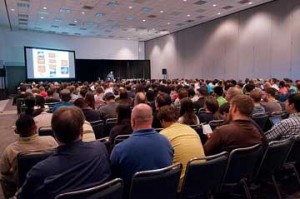
Acclaimed director James Cameron continued his campaign for high frame rate cinema at a panel at SIGGRAPH 2012 L.A. with a pre-recorded 3D message. The panel, hosted by Christie Digital Systems, allowed attendees to experience the difference between how they have seen movies have been for the last 90 years and how they could see movies for decades to come. This panel was designed to explain the benefits of HFR technology.
The standard for filmmakers for decades has been a 24 frames-per-second image capture/projection. Recent advances in technology has given made it possible for films to be recorded at rates of 48 or even 60 fps.
Professionals involved in various aspects of the industry were present on the panel, each with their own stake in how this new technology affects their workplace. Panelists included Phil Oatley of New Zealand’s Park Road Post Production, currently working on New Line Cinema’s The Hobbit, Darin Grant, chief technology officer for Digital Domain Media Group, head of postproduction at DreamWorks Animation Jim Beshears, head of animation technology of DreamWorks Animation, Lincoln Wallen, director Douglas Trumbull, visual effects specialist and senior visual effects supervisor for Industrial Light & Magic, Dennis Muren, producer Jon Landau, director of special projects at Canada’s Side Effects Software, Luke Moore, chief scientific officer at RealD, Matt Cowan, and John Helliker director of Sheridan‘s screen industries research and training centre. Paul Salvini, Christie’s chief technology officer served as the panel’s moderator.
The panel began with a test film put together by Cameron to give the audience a first-hand look at the differences between 24 fps, 48 fps and 60 fps. The film was prefaced Cameron explaining his thoughts and opinions on the benefits of this technology. He also explained that any movie theater with a generation two digital projector only needs a software update to be able to project at 48 or 60 fps.
The film gave several examples of challenges that filmmakers have been forced to deal with for the last century, namely an imperfection of 24 fps image capture referred to as “flickering.” Flickering is when the edges of an image appear to double up and overlap. Flickering can occur when a camera films something that moves faster than 24 fps. The illusion of motion is distorted because movement is taking place between frames.
Most moviegoers are likely aware of this phenomenon, even if they did not know it had a name. They are also probably familiar with higher frame rate projection, since what they see on television is typically projected at 30 or 60 fps.
The benefits to viewers were clearly shown by Cameron’s test film, but this exciting new technology does not come without challenges. And the filmmakers at this panel who were most outspoken about high frame rate cinema appeared to be satisfied to leave these challenges to visual effects artists, software designers, technicians and below-the-line talent.
The conflict of HFR technology lies in how a film is made. It is fairly simple for a filmmaker to capture images for a film at double the frames per second. It is more time-consuming to generate images at twice as many frames per second.
“I would say, on the cautionary side, from what we do in postproduction, our movies that end up at 90 minutes or so, we’re ending up with roughly 150k frames in 3D,” Beshears said. “And that’s a massive amount of data to move around.”
“I think we have to consider the time it’s going to take the artists who work in our industry in order to figure out how to effectively use that in order to do a better storytelling job,” said Grant. “It’s not just a matter of shooting it at 120 frames and it will just look better.”
“We’re going to have to see a lot of work on the tool set side in order to make high frame rate successful.”
When The Hobbit is released later this year, a 48 fps version will be available, making it the first commercial HFR film of this type. As such, it will play a key role in the future of HFR cinema.





